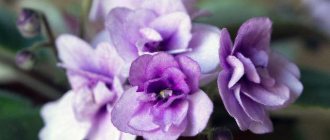A bright flower with an intoxicating aroma adorns many flower beds and garden plots in central Russia.
This plant is a “night resident” . With the onset of dusk, when nature freezes, waiting for the rain, its bright inflorescences on long stems, opening, fill the air with a delicate enchanting aroma.
We will tell you in detail about the unpretentious, easy to grow, ideal for creating group compositions for landscape design Night Violet flower: photos, planting and care and other aspects of cultivation.
Night violet
The night violet (another name is “Matrona’s hesperis”, “mattiola”, “Matrona’s evening violet” ) “moved” to our latitudes from warm Mediterranean Europe. The homeland of some varieties is the foothills of the Caucasus, Central Asian territory.
Vegetarian is a perennial (life period exceeds 2 years). This is a herbaceous plant from the cruciferous family. Under natural conditions, it “loves” to settle both along roads and around rivers and lakes.
A cut bouquet retains its beauty and freshness in its original form for a week and perfectly complements any flower arrangement.
Bright fragrant inflorescences decorate the garden all summer - opening their heads at the end of spring, they say goodbye to the sun at the beginning of autumn.
The pointed leaves, shaped like an elongated oval, delight the eye with the richness of their greenery and the softest “fluff” to the touch.
For risky farming, gardeners prefer mainly selective varieties of night violets with a lifespan of 1 year (the length of the above-ground part does not exceed 0.8 m, the greenery is abundant and dense):
- Matthiola two-horned. Annual, height up to 0.5 m. Well-developed branched stems. The shape of the leaves is an elongated oval, with large teeth along the edges. Does not require pollination by insects. Flowering period – 40 – 50 days. The inflorescences are small (no more than 3 cm), collected in racemes. The color of the petals is pink, lilac-pink;
general information
And not only these plants have similarities with violets. There are others where we find the word violet in their names.
It’s like with night violets. Let's get to know their prominent representative in more detail. With Lyubka:
- This plant was already known in the ancient civilizations of Rome and Greece;
- Perennial. Herbaceous. Grows in the wild. Without cultivated crops: Peduncles grow almost half a meter in height (usually up to 45 cm);
- The small stem is straight. Even short;
- Light green leaves with a narrow oval shape. There are two large ones near the roots. Their length is from 8 to 22 cm. And their width is only 3-6 cm. Rarely one or three. They grow in opposite directions. In the upper part they are even smaller;
- The root system consists of an oblong shape of two undivided tubers (ovoid) and several roots;
- The inflorescence is a rare spike. From 10 to 40 white flowers bloom on it. Perianths are slightly greenish;
- Their flowering time is from June to July. And the fruits ripen in August-September;
- Propagated by tuber roots. Instead of the old two tubers, new ones ripen by autumn.
- The vast territory of our globe is its habitat: Europe;
- On the Russian flat expanses: Residents of the entire European part are well acquainted with it;
- Western and Eastern Siberia;
- In the amazing forests of Altai, Sayan, Caucasus.
Important! But it’s becoming increasingly difficult to meet. Because of the aroma and beautiful inflorescences, outdoor vacationers do not refuse to have them in their bouquets.
Although they know that this plant is in the Red Book of certain regions.
- More often found in coniferous and mixed forests: In numerous shrubs;
- At the edge of the forest;
- Decorating the meadows.
- Grows in dry soils. And with no less success in swampy areas. But it prefers more acidic soils;
- Blooms best in well-lit areas. Also in the shade. But worse.
Seeds
Seed ripening begins at the end of the summer period (the last ten days of August) and continues until the beginning of autumn.
The seed material has a high germination rate; sowing does not require deep burial (it is small in size).
When planting, it is necessary to maintain a distance to ensure a comfortable existence for future seedlings.
What do they look like?
The seeds are in a box - a pod (about 5 cm). They have a dark brown almost black color, oblong shape, about 2-3 mm long. A sign of ripe seeds is a uniform shiny color (well visible under a magnifying glass).
Where is the best place to buy them?
If you are a beginner gardener and have not grown night violet before, then it is better to purchase plant seeds in specialized stores or from trusted breeders (it would be optimal to purchase a whole seed box indicating the parent subspecies and varietal).
You need to pay attention to:
- packaging integrity;
- shelf life of the product (at least 12 months must remain before the end of the sales period);
- compliance with storage conditions: storage temperature – 12 – 15 degrees;
- choose seed material prepared by well-known agricultural producers.
Can I get them myself?
If your dacha or balcony area is already decorated with this plant, then you can prepare the seed material yourself:
- Seeds (located in seed pods - pods) are collected at the end of the growing season, after the onset of the first frost;
- The removed pod is left to dry for up to 2 weeks;
- To store an intact pod, use a paper envelope (the seeds do not lose their viability for 3 years, you can decide for yourself when to plant the night violet) in a cool, well-ventilated area (for example, the bottom compartment of the refrigerator);
- The extracted seeds are wrapped in undyed cotton or linen cloth, or placed in match boxes and stored under the same conditions, but not more than two years.
ATTENTION! The peculiarity of violets is that they spread well by self-sowing, forming abundant thickets. To avoid overgrowing the area, it is recommended to thin out the plant every 2 years.
Reproduction methods
Mattiola rosea reproduces exclusively by seeds. Neither cuttings nor dividing the bush will give any results; on the contrary, they will lead to the death of the bush.
If two-horned gillyflower is not yet growing in the flowerbed, it can be propagated by seedlings. It is recommended to purchase seed material at garden centers.
When the shrub has already established itself on the garden plot, in early September, seeds are collected, which will be suitable for growing seedlings next spring. In addition, matthiola rosea reproduces well by self-sowing. It is enough to thin out or transplant the seedlings to another prepared place next year.
Planting and caring for seedlings at home
To decorate part of the selected garden area or loggia with a night beauty, you can use seedlings obtained independently from collected or purchased seeds.
Levka in the garden.
Read on to learn how to grow this delicate flower from seeds at home.
Priming
The planting substrate is a two-component mixture: turf and sand (ratio 3:1) .
Be sure to use drainage:
- foam chips;
- mid-fraction expanded clay.
To save time and effort, you can purchase a ready-made mixture for growing night violets.
Deadlines
How does it grow from seeds and when to plant them for the best results?
The optimal planting period is the first spring months:
- last ten days of March;
- beginning of April.
The seed is placed in a shallow planting box. An alternative is small containers designed for one seed.
Technology
Since the size of the seeds is very small, they are not deeply buried; the depth of the planting hole should not exceed 10 mm. Sprinkle earth on top.
If a seedling box is used, the distance between the holes should be at least 30 mm.
For proper development, plants create a favorable microclimate: provide watering and lighting. You can organize a mini-greenhouse using plastic film (until 3 leaves appear, after which the seedlings dive).
Watering
Watering is regular, moderate (to prevent drying out of the earthen coma) . Soft water (settled tap water at room temperature) is ideal.
Matthiola seedlings need regular watering.
When 2 leaves are formed on the sprouts, it is necessary to fertilize with a solution of mineral fertilizers.
How and when do shoots appear?
If all conditions have been met, then the first shoots will not take long to appear. Literally after 2 weeks, young shoots appear.
If weather conditions permit, grown shoots (over 7 cm in height) can be taken outside (loggia).
At what age is it better to transplant into open ground?
A young, mature plant with more than 3 leaves and reaching a height of more than 10 cm is ready to be transplanted into open ground.
Thus, from sowing to the moment when planting in open ground in a permanent place takes from 3 to 4 weeks.
How to transplant seedlings?
The pre-selected location is prepared:
- dig transfer holes corresponding to the diameter of the plant with an earthen lump;
- planting holes should be spaced at least 30–40 cm apart from each other.
Next, the sprout is carefully, without damaging the root, moved along with the earthen ball to a new place, watered abundantly and appropriate care is provided with the obligatory root loosening of the soil.
Flowering of a young plant occurs in the second year of life.
History of appearance
Mirabilis flower (night beauty) - plant propagation
Mattiola comes from Asia Minor and Greece. It began to be grown as a garden crop in the 16th century. It was used to decorate houses for the holidays because of its wonderful aroma.
It got its name in honor of the botanist from Italy Andrea Pietro Mattioli
Growing a flower
On the balcony
Night violet can decorate even a limited balcony space. Planting and caring for this plant on the balcony does not require the creation of any very special conditions.
In order for a young plant to feel good after transshipment and gain strength and growth, the following requirements must be met:
- planting is carried out when the street temperature during the day does not fall below 15 degrees. In the evening and at night, it is better to cover the young plant with polyethylene until the flower takes root;
- it is necessary to ensure regular ventilation if the loggia is glazed;
- in summer, the plant must be protected from prolonged exposure to direct sunlight ;
- carry out regular moderate watering and loosen the soil .
Mattiola in a pot on the balcony.
ATTENTION! Since the night violet blooms only in the second year after transshipment, to ensure annual flowering in the selected area of the garden or balcony, the planted plants are renewed gradually.
Damage by diseases and pests
If lesions of any nature are found on the leaves, they are removed to prevent further spread:
- if fungal diseases , the plant is removed and burned;
- when cabbage , treat with valerian (1 teaspoon per liter of water);
Cabbage butterfly.
- Treating the plant with powdered ash will help prevent the appearance of cruciferous flea beetle
Important! Prevention consists of maintaining a distance between plants, regular weeding and avoiding stagnation of water in the soil.
How to care for hesperis
The night violet prefers semi-shaded corners of the garden under the canopy of trees with moderately moist soil. Acidified and overdried soils have a depressing effect on the plant - they become smaller, reducing the intensity of flowering. Due to the small branching of the stem, a single plant is quite unstable and gets lost against the background of other flowers.
To maintain an upright position, hesperis needs support. It is best to plant Hesperis in a dense group - individual plants will merge into a single massif with a blooming lilac-violet spot on top and will serve as support for each other. It makes sense to place the noctule plant between the foreground plants and the background large plants.
- The soil for planting is neutral or slightly alkaline with good drainage.
- It is advisable to place such plantings near gazebos, open verandas, and benches, since the main value of the evening plant is its delicate aroma.
- Requires moderate watering at the beginning of growth and in hot weather.
- Hesperis is frost-resistant - it does not require shelter; snow cover is usually sufficient.
- In the absence of snow cover, you can cover the plantings with non-woven material.
- Hesperis may disappear completely if planted in areas that are flooded in spring.











